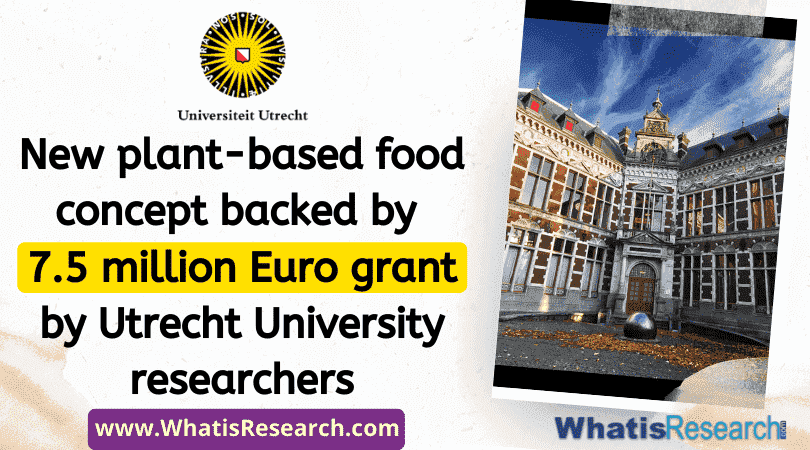In a recent notification, a 7.5 million euro grant, provided by the Novo Nordisk Foundation to the international team of Utrecht University. Here we will discuss this news and update: New plant-based food concept backed by 7.5 million euro grant.
New plant-based food concept backed by 7.5 million euro grant.
About plant-based meat alternatives
Researchers and Scientists across the globe are trying to find Meat replacements for decades now. But they still have not been fully embraced as an alternative to animal protein. They taste different, have fewer nutrients and a completely different mouth-feel.
But according to the researchers of Utrecht University, a new method for processing proteins may make it possible to process plant-based materials into a higher quality form that is better able to compete with meat.
This grant allows researchers to lay the foundations for the new food concept. The grant has been awarded to an international team of researchers at Utrecht University, Københavns Universitet and Danmarks Tekniske Universitet.
“This is amazing news. The grant will allow us to take a huge first step”, says Prof. Han Wösten, who leads the researchers from Utrecht. “Instead of feeding plant-based protein to animals first, and then have the animals convert it into food for people, we want to convert the proteins directly by having them pre-digested in a highly refined process. If we can do that, then it could be a major step forward in sustainability and food security.”
Whati is project PROFERMENT?
Project PROFERMENT (Solid-state fermentation for protein transformations and palatability of plant-based foods) has received a 7.5 million euro grant from the Novo Nordisk Foundation Challenge Programme 2021. The project is part of the research theme Proteins for Tomorrow’s Food. It will begin work on 1 January 2022 and will continue for six years.
Optimal flavor, texture, shelf life and digestibility
Fungi and bacteria play a key role in the new method. The organisms are added to the vegetable material in a controlled manner, upon which they begin digesting the food. The result is a large quantity of high-quality and nutritious proteins that can be used to produce meat alternatives. By fine-tuning the composition of the fungi and bacteria, the researchers believe that it should be possible to achieve the optimal flavor, texture, shelf life and digestibility.
Meat fibres and fungal mycelium
One factor in the process is that the long mycelium of the fungus should produce a texture similar to that of meat. Fungal mycelium are composed of long filaments, called hyphae, which are about as thick as meat fibres and provide a promising foundation for a meaty texture. “That explains why people sense a meaty texture in their mouth when they eat mushrooms like oyster mushrooms, which have long fibres”, says Wösten. “The stems of oyster mushrooms are in high demand today as the basis for vegetarian burgers.”
Fungal growth in 3D
One important question in the project is how a fungus grows through plant materials, and which networks are formed by the hyphae. The researchers will therefore follow the growth of fungi in 3D, in contrast to much of contemporary fungal research which examines mycelium growth in only two dimensions.
“Another question is where the enzymes come from that the fungus uses to break down or digest the vegetable material”. Wösten explains. “Right now, we don’t yet know where or when the enzymes are secreted, or exactly which enzymes are involved. I’m also very interested in whether a fungus has specific hyphae for the job, in addition to hyphae that perform other functions.”
Fungi are semi-animal
Although we usually associate fungi with spoiled food, Wösten says that they are actually much more suitable as meat alternatives than plants. “From an evolutionary perspective, fungi are closer to us than plants. We share a big branch of our evolutionary tree, and we have all sorts of proteins and genes in common. Fungi are a bit like ‘semi-animals’, and they can easily convert substances into variants that our bodies can use.”
Adding bacteria to the mix
In addition to using fungi, the researchers will also add bacteria to examine how the fungi and bacteria influence one another when digesting the plant-based material. “You can use bacteria to get the right composition of amino acids that would be interesting for human consumption”, says Wösten.
“Some bacteria species can create essential amino acids that do not occur in plant-based food. We aim to study how bacteria and fungi affect one another and potentially reinforce each other. In later phases, we will to try out increasingly complex compositions of fungi and bacteria, and eventually realise as many positive characteristics in the product as possible.”
Must read: UAB received research funding of $300 million from the National Institutes of Health
Fighting food spoilage and waste
According to Prof. Wösten, the project could also result in some unexpected benefits. “It’s entirely possible that we’ll learn even more about food spoilage, because that also involves fungi and bacteria. We currently lose 25 percent of our food produce due to spoilage. But as we learn more about spoilage, we can use that knowledge to extend its shelf life and dramatically reduce food waste.”
Final words
This grant is definitely a huge success for the researchers at Utrecht University. This Project PROFERMENT (Solid-state fermentation for protein transformations and palatability of plant-based foods) may bring some good news soon about the meat replacements which will save Billions of animals are slaughtered. So this is all about the news and updates New plant-based food concept backed by 7.5 million euro grant.
Reference read: The 7 Best Plant-Based Meat Alternatives of 2021, According to a Dietitian







